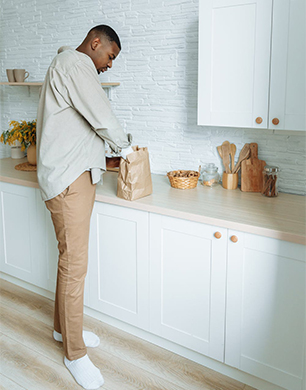
Photo Credit: Thirdman via www.pexels.com
Those who cook only occasionally and make do mainly with a microwave can choose any flooring for the kitchen that fits in with the style of their home. But lately, there has been somewhat of a culinary renaissance and cooking at home has become fun and, in the current situation, practically a necessity! So whilst you might have all the gadgets and gizmos you could ever want – have you ever taken a moment to consider you might need the right floor, too? Let us talk you through the best options for practicality and style!
Whether you’re an amateur or a budding professional chef, it’s no doubt your kitchen is one of the most used rooms in the house. This is why we always advocate first and foremost for practicality in flooring – all those feet stomping up and down means it must be durable, and the potential spillages and hazards that come with it mean it must be safe. Bu what else?
Practical necessities:
- Easy to clean
- Stain resistant
- Non-absorbent
- Non-slip (if possible)
- Heatresistant
Style tips:
- Keep the pattern to a minimum, unless you have an otherwise very neutral space
- Keep textile where they belong – in the 1970s!
- Difficult to clean, and will look worn in no time.
- Think in opposites: light cabinets? Dark floor. And vice-versa!
Types of flooring: our guide
Ceramic tiles
Ceramic tiling is both durable and hygienic, so is therefore still one of the most used floors in the kitchen.The only minor drawback is the difficulty in cleaning in between the tiles. For this reason, we don’t recommend white grouting, but rather grey or dark. There have also been some attempts at silicone grouting but this is not a good option, the silicone will pit over time.
Cast resin flooring
Traditionally used in boot or utility rooms, we now see cast resin floors in the most designer of spaces! Cast resin flooring has excellent user characteristics. It is the ideal choice for fans of minimalism and industrial style; you can even get that really popular polished concrete look. This flooring is great in the kitchen due to its high durability, easy maintenance and the absence of tricky to clean grout. It can be tinted, anti-slip coated, and there is also a choice of matt or gloss finishes. However, it is worth not underestimating the importance of quality installation, as any defects are very difficult to remove.
Laminate flooring
We would definitely move away from cheaper laminate in the kitchen. It’s just a matter of patience when the deteriorating appearance of the floor goes from the “normal wear and tear” category to the “we need a new floor” category. However, a good quality laminate shouldn’t cause any problems in a commonly used kitchen. The floor is easy to maintain, but it doesn’t have the durability of ceramic tile, resin flooring or vinyl.
Vinyl
A very durable engineered flooring that outperforms conventional PVC flooring in terms of performance and price. The advantage is the multitude of colours and patterns. Don’t be afraid to try out different, more contemporary designs than the classic wood imitations. In the kitchen, you will appreciate the easy maintenance and durability of vinyl.
PVC
A relatively durable floor that is easy to maintain. The added advantage is the lower price. The material itself is considered to be disadvantageous as it is generally made from bad chemicals and can be easily worn or warped if you go for a cheap option. However, on a tight budget, it will do in a pinch, and there are some nice finishes available.
Solid wood
Wooden floorboards in the kitchen can work really well. Got a period home? Rip those old carpets or laminate up and see what’s lurking underneath – you could be blessed with some solid wooden floorboards that are only in need of a varnish.
If you want the same effect but don’t have the original features, go for some plank flooring. Again, think about the quality of both the product and the installation, to avoid any unnecessary issues further down the line!
If you want a wooden floor, only go for hard and more durable woods, and you must also allow for faster wear and tear and the need for occasional renovations, especially if you have small children or dogs. Ideally, avoid light-coloured wooden floors where every stain will be visible. Anyone who is uncomfortable with any sign of normal wear and tear will be happier with more mechanically durable floor coverings that are easier to maintain, such as tiles.

